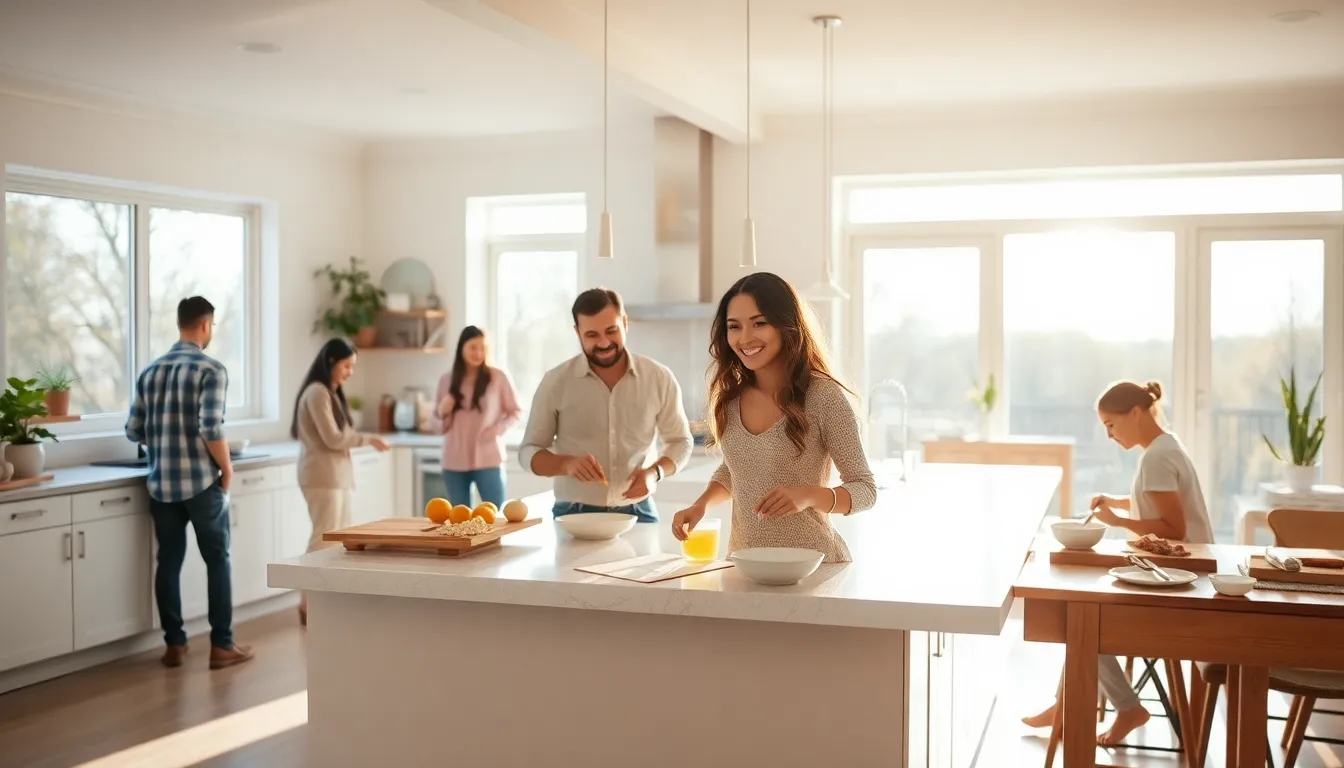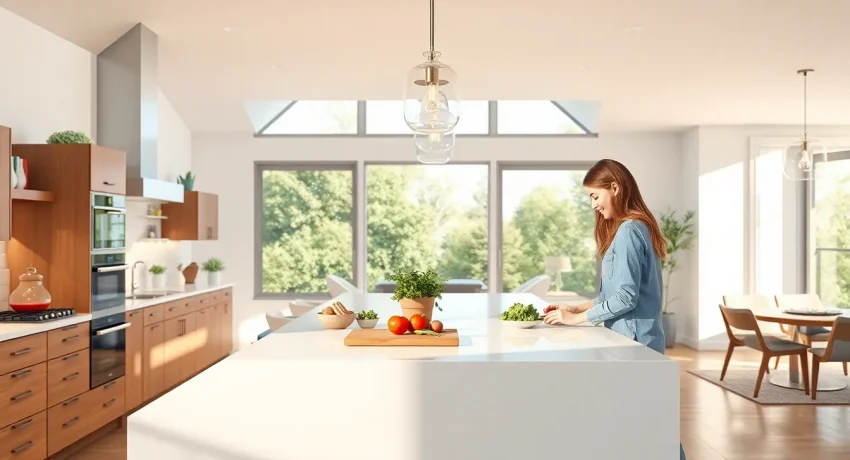Imagine whipping up a gourmet meal while your friends sip cocktails just a few feet away. Open kitchens are the culinary equivalent of a stage where chefs become stars and home cooks bask in the spotlight. This trendy design choice not only invites warmth and connection but also transforms cooking into a social event.
Gone are the days of slaving away behind closed doors, hidden from the laughter and conversation. With an open kitchen, every chop, sauté, and simmer becomes part of the entertainment. Plus, who wouldn’t want to show off their culinary skills while keeping an eye on the latest gossip? Embracing this layout could turn your home into the ultimate gathering spot, where delicious meals and great memories are made. So, is it time to throw open those kitchen doors and let the fun begin?
Table of Contents
ToggleThe Concept of Open Kitchens
Open kitchens create an inviting space where cooking becomes both social and interactive. This trend enhances culinary experiences and encourages connections among friends and family.
Definition and Overview
Open kitchens refer to layouts that integrate the cooking area with living or dining spaces. These designs eliminate barriers, enabling smooth communication between chefs and guests. A notable feature often includes an island or counter space that doubles as a gathering point. People enjoy participating in meal preparation, transforming kitchens into lively hubs. Comfort and warmth flourish as family members interact during cooking. Such environments promote creativity, allowing individuals to experiment with food in a communal setting.
History and Evolution
The concept of open kitchens has roots in various cultures, dating back centuries. Originally, homes featured central hearths, which blended cooking and socializing. In the mid-20th century, post-war architecture popularized the open-concept floor plan, emphasizing spaciousness. Designers recognized that merging cooking and living spaces enhanced functionality. By the 21st century, open kitchens became a beloved choice, reflecting lifestyle changes favoring openness and connectivity. These areas evolved to incorporate modern appliances and stylish designs, striking a balance between aesthetics and practicality. Today, open kitchens symbolize the heart of the home, encapsulating togetherness and the joy of culinary creation.
Benefits of Open Kitchens

Open kitchens provide various advantages that enhance the cooking experience. They create inviting environments that foster interaction and connection among family and friends.
Increased Social Interaction
Open kitchens encourage increased social interaction. Guests often feel more included when they can engage in conversations with the chef. Chefs appreciate the ability to interact with loved ones while preparing meals. This layout turns cooking into a communal event, promoting collaboration during meal prep. Relationships strengthen when everyone participates in creating and enjoying food together. Open kitchens shift the focus from isolation to connection, making gatherings more enjoyable.
Enhanced Natural Light
Open kitchens enhance natural light flow throughout the home. They utilize large windows and open spaces to illuminate cooking areas. Increased sunlight not only creates a warm atmosphere but also improves mood and energy levels. Proper lighting highlights colors and textures in food, making meals visually appealing. Bright spaces encourage creativity in cooking and dining experiences. This design amplifies the sense of space, making even smaller areas feel larger and more inviting.
Design Elements of Open Kitchens
Open kitchens feature distinct design elements that enhance interaction and functionality. Their layout encourages seamless communication between chefs and guests while maximizing the use of space.
Layout and Space Considerations
Open kitchen designs emphasize a flow that connects cooking areas with living or dining spaces. This integration eliminates barriers and promotes engagement during meal preparation. Central islands or large counters serve as focal points, allowing for gathering and collaboration. When entertaining, these features create an inviting atmosphere for guests to join in culinary activities. A well-planned layout maximizes both functionality and comfort, making the kitchen a pivotal area of the home. Diverse arrangements can adapt to various home sizes, ensuring that even small spaces feel spacious and accessible.
Choosing the Right Materials
Selecting appropriate materials plays a crucial role in open kitchen design. Countertops must balance durability and aesthetics, with options such as quartz, granite, or butcher block providing both style and resilience. Backsplashes can enhance visual appeal, utilizing tiles or glass for easy maintenance. Cabinets should reflect the overall design theme, integrating with adjacent living areas. Flooring is another key aspect; materials like hardwood or tile can create continuity throughout the space. Choosing the right colors and textures fosters a warm, inviting atmosphere, complementing the social vibe of the open kitchen.
Challenges of Open Kitchens
Open kitchens present unique challenges that homeowners must consider. Noise and odors from cooking can affect the overall ambiance of the living space.
Noise and Smell Concerns
Cooking activities in open kitchens contribute to noise and odors permeating adjacent living areas. Frying and boiling produce sounds that disrupt conversations or relaxation. Strong cooking smells can linger, impacting air quality, especially in smaller homes. For optimal enjoyment, homeowners may need to invest in effective ventilation systems or exhaust hoods that minimize these concerns. Proper placement of kitchen appliances also helps contain noise and smells, ensuring a balanced home environment.
Maintenance and Cleanliness Issues
Open kitchens require continuous attention to cleanliness due to their visible nature. Grease splatter and food particles can easily migrate to surrounding areas, leading to frequent cleaning efforts. Consistent upkeep of countertops and floors becomes essential in maintaining an inviting atmosphere. Choosing low-maintenance materials helps streamline cleaning routines, but homeowners must remain diligent. Organizing storage solutions can minimize clutter, promoting a tidy appearance that complements the open concept design.
Open kitchens have revolutionized the way people interact with food and each other. They create a vibrant space where cooking becomes a shared experience rather than a solitary task. This design not only enhances social connections but also elevates the overall ambiance of the home.
The blend of cooking and living areas fosters creativity and encourages participation from family and friends. While challenges like noise and odors exist, thoughtful design choices can mitigate these issues. Embracing an open kitchen layout can transform any home into a lively gathering spot, making it the heart of culinary adventures and cherished memories.




